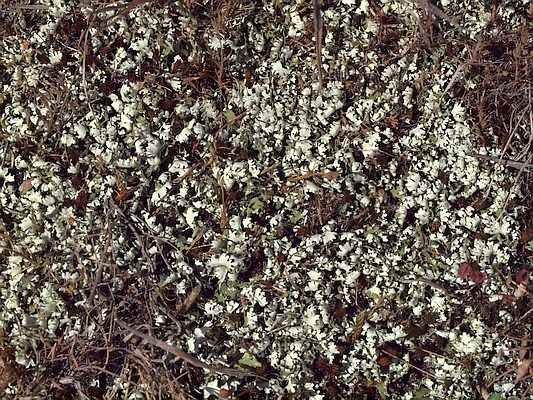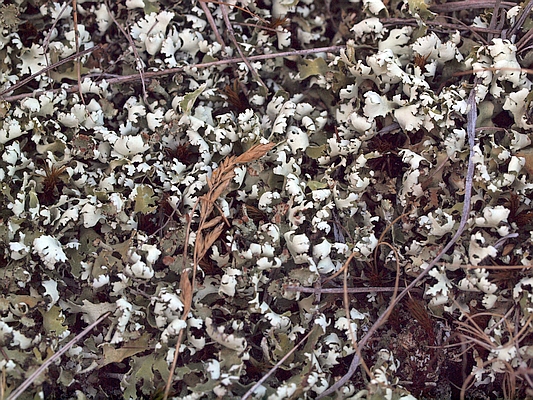Zomersneeuw (Cladonia foliacea)


Zomersneeuw
is een opvallend korstmos dat vooral voorkomt in de duinen, maar ook groeit in
stuifzanden en heidegebieden in het binnenland. Het ontleent zijn naam
aan de grote (tot 3 cm bij 8 mm) geelgroene grondschubben, die bij
droog weer omkrullen waardoor de witte of beige onderkant zichtbaar
wordt. Flinke oppervlakken in de duinen zien er dan uit alsof er
iets wits op de grond uitgestrooid is. Dit korstmos vormt bijna nooit
bekertjes of apotheciŽn (1,2). Binnen Europa komt zomersneeuw voor
vanaf het Middellandse Zeegebied tot in ScandinaviŽ (1,2). De thalli
van zomersneeuw bevatten usninezuur,
een plantenstof die de groei van bacteriŽn en tumorcellen kan afremmen
en die ontstekingsremmend werkt (3,9). Een andere plantenstof, fumaarprotocetraarzuur,
verleent het korstmos bescherming tegen intensieve ultraviolette
straling (4,9).
Thalli van zomersneeuw scheiden onbekende stoffen af die de
groei van concurrerende bladmossen verhinderen of beperken (7). Uit het
feit dat
plantenstoffen uit het thallus met aceton geŽxtraheerd kunnen worden
en zomersneeuw deze behandeling overleeft, blijkt dat dit
korstmos extreme omstandigheden kan verdragen (5). Op
zomersneeuw
kan de schimmel Syzygospora bachmanii parasiteren (8).
Naam
De genusnaam Cladonia is afgeleid van het Griekse woord klados, dat “spruit” betekent. De Latijnse soortnaam foliacea betekent “bladvormig” of “bladerrijk”. Door sommige auteurs worden twee ondersoorten (foliacea en endivifolia) van dit korstmos onderscheiden, maar het onderscheid is niet scherp en er komen vele tussenvormen voor (1,6).
Waar gevonden
Wij
hebben zomersneeuw dikwijls gezien op wandelingen door de duinen, onder
andere in het natuurgebied Bollekamer-Zuid op Texel, en het Kapenglop
op Schiermonnikoog.
Literatuur
1. Association FranÁaise de Lichťnologie. Cladonia foliacea (Huds.) Willd. subsp. endiviifolia = Cladonia convoluta. Document op www.afl-lichenologie.fr.2. Blšttrige Cladonie. Document op de.wikipedia.org.3.
Cavalloro V, Marrubini G, Stabile R, Rossi D, Linciano P, Gheza G,
Assini S, Martino E, Collina S (2021) Microwave-assisted extraction and
HPLC-UV-CD determination of (S)-usnic acid in Cladonia foliacea. Molecules 26:455.4. Farkas E, Birů B, Szabů K, Veres K, Csintalan Z, Engel R (2020) The amount of lichen secondary metabolites in Cladonia foliacea (Cladoniaceae, lichenised Ascomycota). Acta Bot Hung 62:33-48.5. Farkas E, Birů B, Csintalan Z, Veres K (2020) Acetone rinsing tolerance of the lichen species Cladonia foliacea is considerable. Lichenologist 52:325-327.6. Gťrault A. Cladonia foliacea (Huds.) Willd. subsp. foliacea. Document op www.lichensmaritimes.org.7. Giordano S, Alfano F, Basile A, Castaldo Cobianchi R (1999) Toxic effects of the thallus of the lichen Cladonia foliacea on the growth and morphogenesis of bryophytes. Cryptogamie Bryol 20:35-41.8.
Khadhri A, Mendili M, Araķjo MEM, Seaward MRD (2019) Comparative study
of secondary metabolites and bioactive properties of the lichen Cladonia foliacea with and without the lichenicolous fungus Heterocephalacria bachmannii. Symbiosis 79:25-31.9. Yilmaz M, TŁrk A÷, Tay T, KrvanÁ M (2004) The antimicrobial activity of extracts of the lichen Cladonia foliacea and its (-)-Usnic acid, atranorin, and fumarprotocetraric acid constituents. Z Naturforsch 59c:249-254.Terug naar de soortenlijst 
